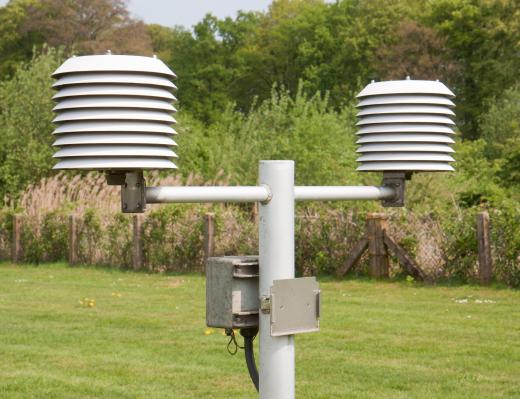A wireless temperature sensor is a device used to measure and transmit temperature information without the use of cables or wires. This sensor relies on a battery-powered microprocessor, which captures temperature and humidity information from the nearby area. The unit then uses radio waves to send this data back to a central receiver or thermostat. A wireless temperature sensor may be used in both residential and commercial settings to maintain a comfortable and efficient environment.
One of the most basic wireless temperature sensor applications involves using these sensors in conjunction with a home weather station or digital display panel. Homes with a central control panel often supply various information to the homeowner, including the temperature within interior and exterior areas of the structure. By placing wireless temperature sensors in these areas, the homeowner can quickly and easily monitor humidity or temperature levels in these spaces. This can help users decide what to wear each day based on outdoor temperatures, or alert the user to excess humidity in basements or garages. These sensors are particularly important in home theaters or wine cellars, where temperature and humidity must be kept within a specific range.

A wireless temperature sensor can also be used to help control the home's heating, ventilation and air conditioning (HVAC) system. Each sensor transmits temperature and humidity information to a central receiver or thermostat, which directs the HVAC system to adjust based on pre-programmed settings. In homes equipped with wireless Internet service, the wireless temperature sensor can also be used to transmit temperature information to remote locations. This allows the homeowner to maintain the environment of the home while on vacation, or to prepare a vacation home for occupancy.

In a commercial building, the wireless temperature sensor plays an important role in the building automation system (BAS). BAS programs allow maintenance crews to monitor an adjust all HVAC, electrical, security, and other systems using a central computer. Typically, multiple wireless sensors are installed throughout the building to measure temperature and humidity conditions. These sensors send a signal to the BAS when conditions are less than optimal, which alerts maintenance personnel to adjust HVAC or other systems as needed.
Wireless temperature sensors provide a number of advantages over traditional hard-wired units. These devices eliminate the need for wires or cabling between the sensor and the main thermostat or control panel. This allows for easy installation without the need to disturb existing walls and ceilings. When used properly, these sensors serve as a simple yet effective way to maximize energy efficiency and comfort while keeping heating and cooling costs to a minimum.
